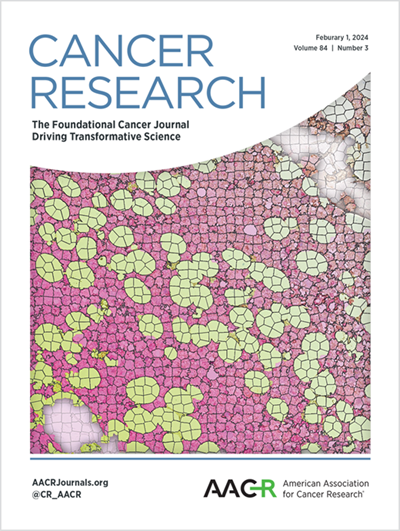EP3-ZNF488轴促进胶质瘤干样细胞自我更新,诱导对肿瘤治疗领域的抵抗力
IF 12.5
1区 医学
Q1 ONCOLOGY
引用次数: 0
摘要
肿瘤治疗场(TTFields)采用低强度的交变电场来发挥抗肿瘤活性,对包括胶质母细胞瘤(GBM)在内的多种癌症都有疗效。不幸的是,癌细胞不可避免地会对TTFields产生抗药性,这凸显了阐明潜在机制以开发诱导持久反应的方法的必要性。利用基于基因网络的机器学习算法,我们对TTFields耐药的GBM细胞进行了研究,发现了由前列腺素E受体3(EP3)和转录因子锌指488(ZNF488)锚定的调控轴。从机理上讲,TTFields诱导EP3上调和核包膜定位,并与ZNF488形成复合物,通过促进胶质瘤干样细胞(GSC)的自我更新来诱导对TTFields的抗性。在对TTFields敏感的GSC中过表达EP3和/或ZNF488会产生抗性并增强自我更新,而表达这些蛋白的非相互作用突变体则会减弱核复合物的形成并阻止抗性。抑制抗性 GSC(包括从 TTFields 抗性 GBM 肿瘤中新鲜分离的细胞)中这一蛋白复合物中的任一伙伴都会使细胞对 TTFields 的细胞毒性作用重新敏感,同时降低自我更新能力和体内致瘤性。重要的是,在对 TTFields 敏感的 GSC 中抑制 EP3 可预先阻止耐药性的发展。EP3-ZNF488轴在TTFields耐药的GBM肿瘤中显著上调,EP3和ZNF488在其他癌症中的共表达与较低的存活率相关。总之,这些结果表明,核EP3-ZNF488轴是建立TTFields耐药性的必要条件和充分条件,强调了以该轴为靶点预防或逆转GBM以及其他癌症耐药性的潜力。本文章由计算机程序翻译,如有差异,请以英文原文为准。
The EP3–ZNF488 Axis Promotes Self-Renewal of Glioma Stem-like Cells to Induce Resistance to Tumor Treating Fields
Tumor Treating Fields (TTFields) employ low-intensity, alternating electric fields to exert antitumor activity and have demonstrated efficacy against multiple cancers, including glioblastoma (GBM). Unfortunately, cancer cells inevitably develop resistance to TTFields, highlighting the need to elucidate the underlying mechanisms to develop approaches to induce durable responses. Using a gene network-based machine-learning algorithm, we interrogated TTFields-resistant GBM cells and uncovered a regulatory axis anchored by the prostaglandin E receptor 3 (EP3) and the transcription factor zinc finger 488 (ZNF488). Mechanistically, TTFields induced EP3 upregulation and nuclear envelope localization, where it formed a complex with ZNF488 to induce resistance to TTFields by promoting self-renewal of glioma stem-like cells (GSC). Overexpression of EP3 and/or ZNF488 in TTFields-sensitive GSC conferred resistance and enhanced self-renewal, while expression of non-interacting mutants of these proteins abrogated formation of the nuclear complex and prevented resistance. Inhibition of either partner in this protein complex in resistant GSC, including those freshly isolated from TTFields-resistant GBM tumors, re-sensitized cells to the cytotoxic effects of TTFields, concomitant with reduced self-renewal and in vivo tumorigenicity. Importantly, inhibition of EP3 in TTFields-sensitive GSC preemptively halted the development of resistance. The EP3–ZNF488 axis was significantly upregulated in TTFields-resistant GBM tumors, and co-expression of EP3 and ZNF488 in other cancers correlated with lower survival rates. Collectively, these results indicate that the nuclear EP3–ZNF488 axis is necessary and sufficient to establish TTFields resistance, underscoring the potential to target this axis to prevent or reverse resistance in GBM and possibly other cancers.
求助全文
通过发布文献求助,成功后即可免费获取论文全文。
去求助
来源期刊

Cancer research
医学-肿瘤学
CiteScore
16.10
自引率
0.90%
发文量
7677
审稿时长
2.5 months
期刊介绍:
Cancer Research, published by the American Association for Cancer Research (AACR), is a journal that focuses on impactful original studies, reviews, and opinion pieces relevant to the broad cancer research community. Manuscripts that present conceptual or technological advances leading to insights into cancer biology are particularly sought after. The journal also places emphasis on convergence science, which involves bridging multiple distinct areas of cancer research.
With primary subsections including Cancer Biology, Cancer Immunology, Cancer Metabolism and Molecular Mechanisms, Translational Cancer Biology, Cancer Landscapes, and Convergence Science, Cancer Research has a comprehensive scope. It is published twice a month and has one volume per year, with a print ISSN of 0008-5472 and an online ISSN of 1538-7445.
Cancer Research is abstracted and/or indexed in various databases and platforms, including BIOSIS Previews (R) Database, MEDLINE, Current Contents/Life Sciences, Current Contents/Clinical Medicine, Science Citation Index, Scopus, and Web of Science.
 求助内容:
求助内容: 应助结果提醒方式:
应助结果提醒方式:


